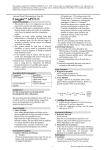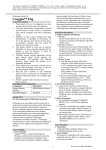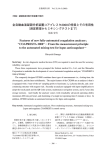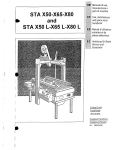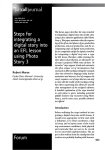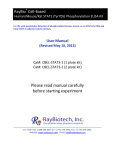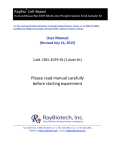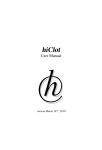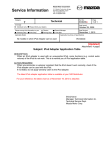Download Internal Information Sheet
Transcript
This product marketed by SEKISUI MEDICAL CO., LTD., Tokyo, Japan is manufactured subject to our supervision as stipulated in the Pharmaceutical Affairs Law of Japan and is allowed to be sold in Japan. For details, please contact us or your local distributors. Prothrombin Time Kit X, V, II are sequentially activated, leading to fibrin precipitation. The prothrombin time (PT) test using this product measures the time taken from the addition of tissue thromboplastin and calcium to fibrin precipitation (coagulation time by seconds) Coagpia™ PT-N General Precautions 1. This product is for in vitro diagnostic use only, and must not be used for any other purposes. 2. Clinicians should make a comprehensive clinical decision based on assay results in conjunction with clinical symptoms and other examination results. 3. Influence on assay values resulting from drug administration is described in Precautions for Use in the package insert for the relevant drugs. In particular, carefully read the section on influence on clinical test results. 4. This product should be used only as directed. Reliability of values cannot be guaranteed if this product is used for purposes or tested by methods other than those stated. 5. If the reagents come in contact with the eyes or mouth, rinse thoroughly with water as first aid, and seek for medical treatment if necessary. 6. Read the user’s manual of your automated analyzer prior to using this kit. Parameters for different automated analyzers are available upon request. 7. Perform a quality control test prior to assay to ensure accuracy. Procedural Precautions 1. Sample Collection and Storage 1) Samples Plasma (citrated plasma) can be used. Do not use plasma with other anticoagulants than citrate 2) Sampling Method i) Promptly mix nine parts of blood sample with one part of 3.2% sodium citrate. Centrifuge in a refrigerated centrifuge at 1500G for 15 minutes to separate plasma and store.2) ii) Avoid contamination with tissue fluid at blood collection, using insufficient amount of sodium citrate solution, and inadequate mixing; they may yield inaccurate test results. 3) Sample Storage Start the test promptly after blood collection. For sample stored in a refrigerator or on ice, perform the test within 4 hours 3) after the collection. 2. Interfering Substances 1) Assay results will not be affected by free bilirubin (up to 20 mg/dL), conjugated bilirubin (up to 20 mg/dL), hemoglobin (up to 500 mg/dL), formazin turbidity (up to 3,000 units), and Intralipos (up to 5%). 2) Samples from patients on anticoagulation treatment may show a prolonged prothrombin time. 3) Plasma contaminated with tissue thromboplastin may show a reduced prothrombin time. 3. Other Precautions Use Calibrator N for Coagpia™ (SEKISUI MEDICAL CO., LTD.) as the calibration material. Description (Kit Components) Component Thromboplastin Reagent Ingredients Thromboplastin (rabbit brain origin) Calcium Chloride Intended Use For the measurement of prothrombin time with plasma The test is commonly used to assist in the diagnosis of various diseases caused by abnormal extrinsic coagulation function, as well as to monitor oral anticoagulation therapy. Assay Procedure 1. Preparation Thromboplastin solution: Reconstitute one vial of thromboplastin reagent with purified water to prepare the thromboplastin solution. The solution is stable at 2-10°C for 8 days after reconstitution. Stir the solution before using this product (use a stirrer if required e.g. before placing in an analyzer.) 2. Assay Method This product is compatible with various types of automated analyzers. Below is a general example of the assay procedure. Prothrombin time (PT) test is a method designed by Quick in 1935 to measure coagulation time and reflects the activities of coagulation factors II (prothrombin), V, VII, X, and fibrinogen levels. The test therefore provides a general overview of these coagulation factors, and has been an essential screening test for patients with bleeding tendencies. In addition, it has been widely used to monitor anticoagulation treatment with an oral anticoagulant, warfarin. 1) Assay Principle 1. Assay Principle The addition of tissue thromboplastin and calcium to the plasma sample activates factor VII. Factors 1 Revised: (Jan) 2011 (3rd edition) This product marketed by SEKISUI MEDICAL CO., LTD., Tokyo, Japan is manufactured subject to our supervision as stipulated in the Pharmaceutical Affairs Law of Japan and is allowed to be sold in Japan. For details, please contact us or your local distributors. Plasma sample 50 μL 37°C 37°C test. 2) This product contains sodium azide as a preservative. Therefore, if the reagents come in contact with the eyes, mouth or skin, rinse immediately with water as first aid, and consult a doctor if necessary. Thromboplastin solution should be handled likewise. 2. Precautions for Use 1) Store this product as directed. Store the prepared thromboplastin solution at 2-10°C with a plug cap on the vial and avoid freezing. Freezing can cause deterioration of the reagents, which can produce inaccurate results. 2) Do not use expired reagents. Reliable assay values cannot be obtained if expired reagents are used. 3) Do not replenish the reagents. 4) Do not mix reagents of different lots. 5) Do not perform the assay under direct sunlight. 3. Precautions for Disposal 1) Before disposal, used samples and their containers must be soaked in sodium hypochlorite solution at a concentration of greater than 0.1% for more than an hour or autoclaved at 121ºC for 20 minutes. 2) To prevent infections from spilled samples or solutions containing samples, wipe the spill area thoroughly with solutions such as sodium hypochlorite solutions at a concentration of greater than 0.1%. 3) The reagents and samples should be disposed in accordance with medical waste disposal regulations or related regulations. 4) The reagents should be disposed in accordance with water pollution control regulations or related regulations. 5) This product contains sodium azide as a preservative. Sodium azide may react with lead or copper plumbing to produce highly explosive metal azide. Therefore, reagents should be flushed out with a large amount of water when discarding. The prepared thromboplastin solution should be handled similarly. 4. Other Precautions Do not use the containers for any other purposes. Thromboplastin solution 100 µL Measurement of coagulation time Calibration material: Use Calibrator N for Coagpia™ (value assigned by SEKISUI MEDICAL CO., LTD.) 3. Operating Precautions 1) Bring the thromboplastin reagent to room temperature (15-30°C) before reconstitution. 2) Add purified water to one vial of thromboplastin reagent, cap, and gently invert to mix. Leave the vial for 30 minutes at room temperature (15-30°C). Make sure that the contents are completely dissolved and use after gently mixing by several inversions. Do not mix vigorously. 3) After the completion of the assay seal the bottle and store at 2-10°C. Assessment of Results 1. Reference Interval4) 80-120% (PT activity) 2. Precautions for Assessment Reactions with non-target substances contained in the sample or interfering reactions may occur in some samples. If the assay results seem unreliable, confirm the results by repeating the assay or by performing another analytical assay. Performance 1. Sensitivity The prothrombin time of undiluted and four-fold diluted normal plasma is 14 or less, and 25-42 seconds, respectively. 2. Accuracy 80-120% of the expected assay value 3. Within-run Reproducibility Coefficient of variation ≤ 10% (Test methods used for 1 to 3 are in-house methods.) 4. Measurement Range (on Coapresta 2000) 5) 5-130% 5. Correlation (on Coapresta 2000)5) 1) N = 138, r = 0.994, y = 0.96x - 1.6 Reference method: Coagulation time method (MHLW approved IVD) 2) N = 138, r = 0.985, y = 1.03x - 5.1 Reference method: Coagulation time method (MHLW approved IVD) 6. Standard Calibration Material Pooled plasma of healthy individuals (in-house standard material) Storage and Shelf Life 1. Storage temperature: 2-10C 2. Shelf-life: 2 years from the date of manufacture (The expiration date is printed on the outside of the package.) Precautions and Warnings 1. Handling Precautions 1) All samples used in the test should be handled as if potentially infectious for HIV, HBV and HCV. To prevent infection, use disposable gloves and avoid mouth pipetting during the 2 Revised: (Jan) 2011 (3rd edition) This product marketed by SEKISUI MEDICAL CO., LTD., Tokyo, Japan is manufactured subject to our supervision as stipulated in the Pharmaceutical Affairs Law of Japan and is allowed to be sold in Japan. For details, please contact us or your local distributors. Package Contents Description Configuration Coagpia™ Thromboplasti 4 mL (lyophilized) PT-N n reagent x 10 Reagents are available in other configurations. Contact SEKISUI MEDICAL CO., LTD. for details. References 1) Masamitsu Kanai: Clinical examination method summary. Kanehara Co., LTD, 32nd edition, pp. 413, 2005. 2) Edited by the Japanese Society for Laboratory Hematology: Standard hematologic tests. Ishiyaku Publishers, Inc., pp. 75-78, 2003. 3) Edited by the Japanese Society for Laboratory Hematology: Standard hematologic tests. Ishiyaku Publishers, Inc., pp. 136-138, 2003. 4) Data book of clinical examination. IGAKU-SHOIN Ltd,p p. 315, 2001-2002. 5) SEKISUI MEDICAL CO., LTD. In-house data Marketing Authorization Holder SEKISUI MEDICAL CO.,LTD. 13-5, Nihonbashi 3-chome, Chuo-ku, Tokyo, Japan [email protected] "Coagpia" is a trademark owned by SEKISUI MEDICAL CO.,LTD. JAPAN, and is registered in Japan and/or other countries. 3 Revised: (Jan) 2011 (3rd edition)



